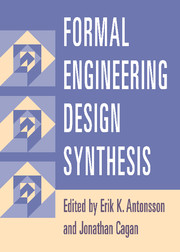Book contents
- Frontmatter
- Contents
- Contributing Authors
- Foreword
- Preface
- Introduction
- 1 Vitruvius Redux
- 2 How to Calculate with Shapes
- 3 Engineering Shape Grammars
- 4 Creating Structural Configurations
- 5 Microsystem Design Synthesis
- 6 Function-Based Synthesis Methods in Engineering Design
- 7 Artificial Intelligence for Design
- 8 Evolutionary and Adaptive Synthesis Methods
- 9 Kinematic Synthesis
- 10 Systematic Chemical Process Synthesis
- 11 Synthesis of Analog and Mixed-Signal Integrated Electronic Circuits
- 12 Mechanical Design Compilers
- 13 Scientific Discovery and Inventive Engineering Design
- Index
7 - Artificial Intelligence for Design
Published online by Cambridge University Press: 10 October 2009
- Frontmatter
- Contents
- Contributing Authors
- Foreword
- Preface
- Introduction
- 1 Vitruvius Redux
- 2 How to Calculate with Shapes
- 3 Engineering Shape Grammars
- 4 Creating Structural Configurations
- 5 Microsystem Design Synthesis
- 6 Function-Based Synthesis Methods in Engineering Design
- 7 Artificial Intelligence for Design
- 8 Evolutionary and Adaptive Synthesis Methods
- 9 Kinematic Synthesis
- 10 Systematic Chemical Process Synthesis
- 11 Synthesis of Analog and Mixed-Signal Integrated Electronic Circuits
- 12 Mechanical Design Compilers
- 13 Scientific Discovery and Inventive Engineering Design
- Index
Summary
INTRODUCTION
Artificial Intelligence (AI) is the study of knowledge representations and inference mechanisms necessary for reasoning and problem solving. AI encompasses a wide variety of topics such as logic, planning, machine vision, and natural language processing. This chapter focuses on those topics that are the most useful for design synthesis: search, knowledge-based systems, machine learning, and qualitative physical reasoning.
This chapter is divided into four main sections, one for each of these topics. Each section discusses the theory behind the techniques, provides examples of their application to synthesis, and summarizes the current understanding about their usefulness. To the extent possible, the sections are independent of one another, and thus can be read in any order without loss of continuity. This chapter draws examples primarily from mechanical engineering; however, the techniques are suitable for many kinds of design problems. The earlier sections describe more mature technologies, whereas the later sections describe technologies with much of the potential left to be explored. The chapter concludes with thoughts about future directions.
SEARCH
Search is one of the oldest AI techniques and was the basis of much of the early work in AI. For example, the Logic Theorist of Newell and Simon (Newell, Simon, and Shaw, 1963) which was one of the first implemented AI systems, used search to prove theorems in propositional calculus (logic). Search has continued to be an important AI tool and has contributed to a number of significant accomplishments.
- Type
- Chapter
- Information
- Formal Engineering Design Synthesis , pp. 228 - 269Publisher: Cambridge University PressPrint publication year: 2001
- 4
- Cited by



